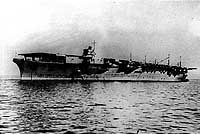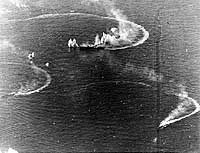
Zuikaku, "sister ship" of the 29,800-ton aircraft carrier Shokaku, was built at Kobe, Japan. She was commissioned in September 1941 and took part in the attack on Pearl Harbor the following December. During the great Japanese Pacific offensive of late 1941 and early 1942, Zuikaku was a participant in attacks on Rabaul, the East Indies, and the Indian Ocean. While covering an intended invasion of Port Moresby, New Guinea, in early May 1942, Zuikaku and Shokaku formed the Japanese side of the World's first significant battle between aircraft carriers, the Battle of the Coral Sea. On 8 May, her planes helped disable USS Lexington (CV-2) and damage USS Yorktown (CV-5). In return, Shokaku was seriously damaged, and Zuikaku's air group was greatly depleted, ensuring that both ships were unavailable for the pivotal Battle of Midway in June.
During the rest of 1942, Zuikaku was an important component of the Japanese forces involved in the Guadalcanal campaign, taking part in the carrier battles of the Eastern Solomons in August and Santa Cruz Islands in October. After the long lull in carrier actions that covered all of 1943 and the first part of 1944, Zuikaku again engaged her American opposite numbers in the Battle of the Philippine Sea, on 19-20 June 1944. That action, which cost Japan three more carriers, hundreds of planes and most of the rest of her trained carrier pilots, reduced her once-irresistable aircraft carrier fleet to a state of virtual impotence. Zuikaku was damaged in the battle, but was soon repaired.
In October 1944, Zuikaku led the remaining Japanese carriers in the role of "bait" to divert U.S. carrier planes away from the surface forces that were attempting to attack U.S. ships off Leyte, in the Philippines. This mission was successful, though it did not lead to Japanese victory in any component of the Battle of Leyte Gulf, and it came at great cost to Zuikaku and her consorts, who had few planes embarked to defend themselves. In the resulting Battle off Cape Engano, on 25 October 1944, the four Japanese aircraft carriers were repeatedly hit by U.S. carrier planes' bombs and torpedoes. All of them, including Zuikaku, were sunk.
This page features, or provides links to, all the views we have concerning the Japanese aircraft carrier Zuikaku.
For more views of Zuikaku, see:
| If you want higher resolution reproductions than the digital images presented here, see: "How to Obtain Photographic Reproductions." |
Click on the small photograph to prompt a larger view of the same image.
|
Photo #: NH 73067 Zuikaku (Japanese Aircraft Carrier, 1941-1944) Photographed dated 25 September 1941, the day she was completed for service. Courtesy of Mr. Kazutoshi Hando, 1970. U.S. Naval History and Heritage Command Photograph. Online Image: 114KB; 740 x 520 pixels |
 |
|
Photo #: 80-G-238025 Battle of the Philippine Sea, June 1944 Japanese aircraft carrier Zuikaku (center) and two destroyers maneuvering, while under attack by U.S. Navy carrier aircraft, during the late afternoon of 20 June 1944. Zuikaku was hit by several bombs during these attacks, but survived. Official U.S. Navy Photograph, now in the collections of the National Archives. Online Image: 144KB; 740 x 590 pixels Reproductions of this image may also be available through the National Archives photographic reproduction system. |
 |
For more views of the Japanese aircraft carrier Zuikaku,
see:
NOTES:
| If you want higher resolution reproductions than the digital images presented here, see: "How to Obtain Photographic Reproductions." |
Page made 20 May 2000
Coding updated 3 May 2009